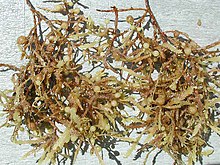Sargassum: Difference between revisions
m Urls |
|||
| Line 53: | Line 53: | ||
* [http://www.habitas.org.uk/invasive/ habitas.org.uk] |
* [http://www.habitas.org.uk/invasive/ habitas.org.uk] |
||
* [http://www.irishseaweed.com/PDF/smutposter.pdf irishseaweed.com] |
* [http://www.irishseaweed.com/PDF/smutposter.pdf irishseaweed.com] |
||
* [http://www.mbari.org/staff/conn/botany/browns/jacquie/repro.htm ''Sargassum'' |
* [http://www.mbari.org/staff/conn/botany/browns/jacquie/repro.htm ''Sargassum'' reproduction.] |
||
[[Category:Fucales]] |
[[Category:Fucales]] |
||
Revision as of 14:03, 17 March 2012
| Sargassum | |
|---|---|

| |
| Scientific classification | |
| Domain: | |
| Kingdom: | |
| Phylum: | |
| Class: | |
| Order: | |
| Family: | |
| Genus: | Sargassum
|
| Species | |
| |
Sargassum is a genus of brown (class Phaeophyceae) macroalga (seaweed) in the order Fucales. Numerous species are distributed throughout the temperate and tropical oceans of the world, where they generally inhabit shallow water and coral reefs. However, the genus may be best known for its planktonic (free-floating) species. While most species within the class Phaeophyceae are predominantly cold water organisms that benefit from nutrients upwelling, genus Sargassum appears to be an exception to this general rule.[1] Any number of the normally benthic species may take on a planktonic, often pelagic existence after being removed from reefs during rough weather. However, two species (S. natans and S. fluitans) have become holopelagic — reproducing vegetatively and never attaching to the seafloor during their lifecycle. The Atlantic Ocean's Sargasso Sea was named after the algae, as it hosts a large amount of Sargassum.[2]
Description
Species of this genus of algae may grow to a length of several metres. They are generally brown or dark green in color and consist of a holdfast, a stipe, and a frond. Oogonia and antheridia occur in conceptacles embedded in receptacles on special branches.[3] Some species have berrylike gas-filled bladders which help keep the fronds afloat to promote photosynthesis. Many have a rough sticky texture, which together with a robust but flexible body, helps it to withstand strong water currents.
The thick masses of Sargassum provide an environment for a distinctive and specialised group of marine animals and plants, many of which are not found elsewhere.
Sargassum is commonly found in the beach drift near Sargassum beds where they are also known as gulfweed, a term also used to include all seaweed species washed up on shore.
Sargassum species are found throughout tropical areas of the world and are often the most obvious macrophyte in near-shore areas where Sargassum beds often occur near coral reefs. The plants grow subtidally and attach to coral, rocks or shells in moderately exposed or sheltered rocky or pebble areas. In some cases (e.g., the Sargasso Sea) there are floating populations of Sargassum.
Sargassum muticum
Sargassum muticum is a large brown seaweed of the class Phaeophyceae. It grows attached to rocks by a perennial holdfast up to 5 cm in diameter. From this holdfast the main axis grows to a maximum of 5 cm high. The leaf-like laminae and primary lateral branches grow from this stipe. In warm waters it can grow to 12 m long, however in British waters it gives rise to a single main axis with secondary and tertiary branches which are shed annually. Numerous small 2–6 mm stalked air vesicles provide buoyancy. The reproductive receptacles are also stalked and develop in the axils of leafy laminae. It is self fertile.
History
Sargassum was named by the Portuguese sailors who found it in the Sargasso Sea after a species of rock rose (Helianthemum) that grew in their water wells at home and that was called sargaço in Portuguese.[4]
The Florida Keys and its smaller islands are well known for their high levels of Sargassum covering their shores. Gulfweed was observed by Columbus. Although it was formerly thought to cover the entirety of the Sargasso Sea, making navigation impossible, it has since been found to occur only in drifts.
Sargassum is also cultivated and cleaned for use as an herbal remedy. Many Chinese herbalists prescribe powdered Sargassum in paper packets of 0.5 gm, to be dissolved in warm water and drunk as a tea. It is said to remove excess phlegm. When sold in this application it is commonly referred to as Seaweed Sargassum Tea.
Further reading
- Critchley, A.T., Farnham, W.F. and Morrell, S.L. 1983. A chronology of new European sites of attachment for the invasive brown alga, Sargassum muticum, 1973 - 1981. Journal of the Marine Biological Association of the United Kingdom, 63: 799 - 811.
- Boaden, P.J.S. 1995. The adventive seaweed Sargassum muticum (Yendo) Fensholt in Strangford Lough, Northern Ireland. Ir. Nat. J. 25 111 - 113.
- Davison, D.M. 1999. Sargassum muticum in Strangford Lough, 1995–1998; a review of the introduction and colonisation of Strangford Lough MNR and cSAC by the invasive brown alga Sargassum muticum. Environment and Heritage Service Research and Development Series. No.99/27 ISSN 1367 - 1979.
References
- ^ C.Michael Hogan. 2011. Brown algae. eds. E.Monosson & C.J.Cleveland. Encyclopedia of Earth. National Council for Science and the Environment. Washington DC
- ^ "Sargasso". Straight Dope.
- ^ Abbott, I.A. and Hollenberg, G.J. 1976. Marine Algae of California. Stanford University
- ^ Gómez de Silva, Guido 1988. Breve diccionario etimológico de la lengua española. Fondo de Cultura Económica, Mexico City, ISBN 968-16-2812-8, p. 627.
